Femtosecond Laser Irradiation of Carbon Nanotubes to Metal Electrodes
Abstract
:1. Introduction
2. Experimental Details
3. Results and Discussion
4. Conclusions
Author Contributions
Funding
Conflicts of Interest
References
- Iijima, S. Helical microtubules of graphitic carbon. Nature 1991, 354, 56–58. [Google Scholar] [CrossRef]
- Changxin, C.; Tiening, J.; Yafei, Z. Progress in improvement methods of carbon nanotube/metal contact. J. Inorg. Mater. 2012, 27, 449–457. [Google Scholar]
- Yang, L.; Cui, J.; Wang, Y. Research Progress on the Interconnection of Carbon Nanotubes. New Carbon Mater. 2016, 31, 1–17. [Google Scholar] [CrossRef]
- Derycke, V.; Martel, R.; Appenzeller, J.; Avouris, P. Controlling doping and carrier injection in carbon nanotube transistors. Appl. Phys. Lett. 2002, 80, 2773. [Google Scholar] [CrossRef]
- Maki, H.; Suzuki, M.; Ishibashi, K. Local change of carbon nanotube-metal contacts by current flow through electrodes. Jpn. J. Appl. Phys. 2004, 43, 2027. [Google Scholar] [CrossRef]
- Dong, L.; Youkey, S.; Bush, J.; Jiao, J.; Dubin, V.M.; Chebiam, R.V. Effects of local joule heating on the reduction of contact resistance between carbon nanotubes and metal electrodes. J. Appl. Phys. 2007, 101, 49. [Google Scholar] [CrossRef]
- Yu, M. Strength and breaking mechanism of multiwalled carbon nanotubes under tensile load. Science 2000, 287, 637–640. [Google Scholar] [CrossRef]
- Bachtold, A.; Henny, M.; Terrier, C.; Strunk, C.; Schönenberger, C.; Salvetat, J.P.; Bonard, J.M.; Forro, L. Contacting carbon nanotubes selectively with low-Ohmic contacts for four-probe electric measurements. Appl. Phys. Lett. 1998, 73, 274–276. [Google Scholar] [CrossRef]
- Wei, B.Q.; Vajtai, R.; Ajayan, P.M. Reliability and current carrying capacity of carbon nanotubes. Appl. Phys. Lett. 2001, 79, 1172–1174. [Google Scholar] [CrossRef]
- Jingqi, L.I.; Zhang, Q.; Chan-Park, M.B.; Yan, Y. Annealing effects on electric contacts between carbon nanotubes and electrodes. Int. J. Nanosci. 2008, 05, 401–406. [Google Scholar]
- Kim, S.; Kulkarni, D.D.; Rykaczewski, K.; Henry, M.; Tsukruk, V.V.; Fedorov, A.G. Fabrication of an ultralow-resistance Ohmic contact to mwcnt–metal interconnect using graphitic carbon by electron beam-induced deposition (EBID). IEEE Trans. Nanotechnol. 2012, 11, 1223–1230. [Google Scholar]
- Silveira, J.V.; Savu, R.; Canesqui, M.A.; Mendes Filho, J.; Swart, J.W.; Souza Filho, A.G.; Moshkalev, S.A. Improvement of the electrical contact between carbon nanotubes and metallic electrodes by laser irradiation. In Proceedings of the Microelectronics Technology & Devices, Curitiba, Brazil, 2–6 September 2013. [Google Scholar]
- Xuan, L.; Long, K.; Yarong, W.; Bikui, L.; Shiming, W.; Yafei, Z. Laser-induced swcnts-al thin film and field emission property. High Power Laser Part. Beams 2015, 27. [Google Scholar] [CrossRef]
- Bhat, A.; Balla, V.K.; Bysakh, S.; Basu, D.; Bose, S.; Bandyopadhyay, A. Carbon nanotube reinforced cu–10sn alloy composites: Mechanical and thermal properties. Mater. Sci. Eng. A 2011, 528, 6727–6732. [Google Scholar] [CrossRef]
- Savalani, M.M.; Ng, C.C.; Li, Q.H.; Man, H.C. In situ formation of titanium carbide using titanium and carbon-nanotube powders by laser cladding. Appl. Surf. Sci. 2012, 258, 3173–3177. [Google Scholar] [CrossRef]
- Qi, F.; Chen, N.; Wang, Q. Dielectric and piezoelectric properties in selective laser sintered polyamide11/batio 3/cnt ternary nanocomposites. Mater. Des. 2018, 143, 72–80. [Google Scholar] [CrossRef]
- Cui, J.; Yang, L.; Wang, Y. Size effect of melting of silver nanoparticles. Rare Met. Mater. Eng. 2014, 43, 369–374. [Google Scholar]
- Castillejo, M.; Ossi, P.M.; Zhigilei, L. Lasers in Materials Science; Springer: Berlin, Germany, 2014. [Google Scholar]
- Schrider, K.J. Femtosecond Laser Interaction with Ultrathin Metal Films: Modifying Structure, Composition, and Morphology. Ph.D. Thesis, University of Michigan Mlibrary, Ann Arbor, MI, USA, 2017; pp. 80–81. [Google Scholar]
- Zhang, J.; Cui, J.; Wang, X.; Wang, W.; Mei, X.; Yi, P.; Yang, X.; He, X. Recent process in the preparation of horizontally ordered carbon nanotube assemblies from solution. Phys. Status Solidi A 2018, 2018, 1700719. [Google Scholar] [CrossRef]
- Zhang, J.; Cui, J.; Wang, X.; Wang, W.; Mei, X.; Long, W.; Sun, H.; He, X.; Xie, H. Large-scale assembly of single-walled carbon nanotubes based on aqueous solution. Integr. Ferroelectr. 2018, 190, 1–9. [Google Scholar] [CrossRef]
- Cui, J.; Yang, L.; Xie, H.; Wang, Y.; Mei, X.; Wang, W.; Wang, K.; Hou, C. New Optical Near-Field Nanolithography with Optical Fiber Probe Laser Irradiating Atomic Force Microscopy Probe Tip. Integr. Ferroelectr. 2016, 169, 124–132. [Google Scholar] [CrossRef]
- Cui, J.; Yang, L.; Wang, Y.; Mei, X.; Wang, W.; Hou, C.; Cheng, B.; Dai, Q. Local field enhancement characteristics in a tapered metal-coated optical fiber probe for nanolithography. Integr. Ferroelectr. 2015, 164, 90–97. [Google Scholar] [CrossRef]
- Collins, P.G.; Arnold, M.S.; Avouris, P. Engineering carbon nanotubes and nanotube circuits using electrical breakdown. Science 2001, 292, 706–709. [Google Scholar] [CrossRef]
- Cui, J.; Zhang, J.; Wang, X.; Barayavuga, T.; He, X.; Mei, X.; Wang, W.; Jiang, G.; Wang, K. Near-Field Optical Characteristics of Ag Nanoparticle within the Near-Field Scope of A Metallic AFM Tip Irradiated by SNOM Laser. Integr. Ferroelectr. 2017, 178, 117–124. [Google Scholar] [CrossRef]
- Cui, J.; Barayavuga, T.; Wang, X.; Mei, X.; Wang, W.; Wang, K. Molecular Dynamics Study of Nanojoining between Axially Positioned Ag Nanowires. Appl. Surf. Sci. 2016, 378, 57–62. [Google Scholar] [CrossRef]
- Cui, J.; Wang, X.; Barayavuga, T.; Mei, X.; Wang, W.; He, X. Nanojoining of Crossed Ag Nanowires: A Molecular Dynamics Study. J. Nanopart. Res. 2016, 18, 175. [Google Scholar] [CrossRef]
- Cui, J.; Yang, L.; Wang, Y.; Mei, X.; Wang, W.; Hou, C. Nanospot Soldering Polystyrene Nanoparticles with Optical Fiber Probe Laser Irradiating Metallic AFM Probe based on Near-Field Enhancement Effect. ACS Appl. Mater. Interfaces 2015, 7, 2294–2300. [Google Scholar] [CrossRef]
- Yang, L.; Cui, J.; Wang, Y.; Mei, X.; Wang, W.; Wang, K.; Hou, C. Nanospot Soldering of Carbon Nanotubes Using Near-Field Enhancement Effect of AFM Probe Irradiated by Optical Fiber Probe Laser. RSC Adv. 2015, 5, 56677–56685. [Google Scholar] [CrossRef]
- Cui, J.; Yang, L.; Mei, X.; Wang, Y.; Wang, W.; Liu, B.; Fan, Z. Nanomanipulation of Carbon Nanotubes with the Vector Scanning Mode of Atomic Force Microscope. Integr. Ferroelectr. 2015, 163, 81–88. [Google Scholar] [CrossRef]
- Cui, J.; Yang, L.; Wang, Y. Creation and Measurement of Nanodots with Combined-Dynamic mode “Dip-Pen” Nanolithography based on Atomic Force Microscope. Micro Nano Lett. 2014, 9, 189–192. [Google Scholar] [CrossRef]
- Cui, J.; Yang, L.; Wang, Y.; Guo, S.; Xie, H.; Sun, L. Experimental Study on the Creation of Nanodots with Combined-Dynamic mode “Dip-Pen” Nanolithography. Integr. Ferroelectr. 2014, 151, 1–7. [Google Scholar] [CrossRef]
- Wang, X.; Cui, J.; Zhang, J.; Wang, W.; Mei, X.; Long, W.; Sun, H.; He, X.; Xie, H. Simulation study of near-field enhancement on an Ag nanoparticle dimer system in a laser-induced nanowelding process. Integr. Ferroelectr. 2018, 191, 1–8. [Google Scholar] [CrossRef]
- Lin, L.; Liu, L.; Zou, G.; Zhou, Y.N.; Peng, P.; Duley, W.W. In situ nanojoining of y- and t-shaped silver nanowires structures using femtosecond laser radiation. Nanotechnology 2016, 27, 125201. [Google Scholar] [CrossRef] [PubMed]
- Cui, J.; Yang, L.; Wang, Y. Molecular Dynamics Simulation Study of the Melting of Silver Nanoparticles. Integr. Ferroelectr. 2013, 145, 1–9. [Google Scholar] [CrossRef]
- Theogene, B.; Cui, J.; Wang, X.; Wang, W.; Mei, X.; Yi, P.; Yang, X.; He, X.; Xie, H. 3-D finite element calculation of electric field enhancement for nanostructures fabrication mechanism on silicon surface with AFM tip induced local anodic oxidation. Integr. Ferroelectr. 2018, 190, 1–13. [Google Scholar] [CrossRef]
- Cui, J.; Zhang, J.; Barayavuga, T.; Wang, X.; He, X.; Yang, L.; Xie, H.; Mei, X.; Wang, W. Nanofabrication with the Thermal AFM Metallic Tip Irradiated by Continuous Laser. Integr. Ferroelectr. 2017, 179, 140–147. [Google Scholar] [CrossRef]
- Cui, J.; Yang, L.; Wang, Y. Simulation Study of Near-Field Enhancement on a Laser-Irradiated AFM Metal Probe. Laser Phys. 2013, 23, 076003. [Google Scholar] [CrossRef]
- Cui, J.; Yang, L.; Wang, Y. Nanowelding Configuration between Carbon Nanotubes in Axial Direction. Appl. Surf. Sci. 2013, 264, 713–717. [Google Scholar] [CrossRef]
- Cui, J.; Zhang, J.; He, X.; Mei, X.; Wang, W.; Yang, X.; Xie, H.; Yang, L.; Wang, Y. Investigating Interfacial Contact Configuration and Behavior of Single-Walled Carbon Nanotubes-based Nanodevice with Atomistic Simulations. J. Nanopart. Res. 2017, 19, 110. [Google Scholar] [CrossRef]
- Cui, J.; Yang, L.; Zhou, L.; Wang, Y. Nanoscale Soldering of Axially Positioned Single-Walled Carbon Nanotubes: A Molecular Dynamics Simulation Study. ACS Appl. Mater. Interfaces 2014, 6, 2044–2050. [Google Scholar] [CrossRef]
- Cui, J.; Yang, L.; Wang, Y. Molecular Dynamics Study of the Positioned Single-Walled Carbon Nanotubes with T.-, X-, Y- Junction during Nanoscale Soldering. Appl. Surf. Sci. 2013, 284, 392–396. [Google Scholar] [CrossRef]
- Nurbawono, A.; Zhang, A.; Cai, Y.; Wu, Y.; Feng, Y.P.; Zhang, C. Nanowelding of carbon nanotube-metal contacts: An effective way to control the schottky barrier and performance of carbon nanotube based field effect transistors. J. Chem. Phys. 2012, 136, 174704. [Google Scholar] [CrossRef]
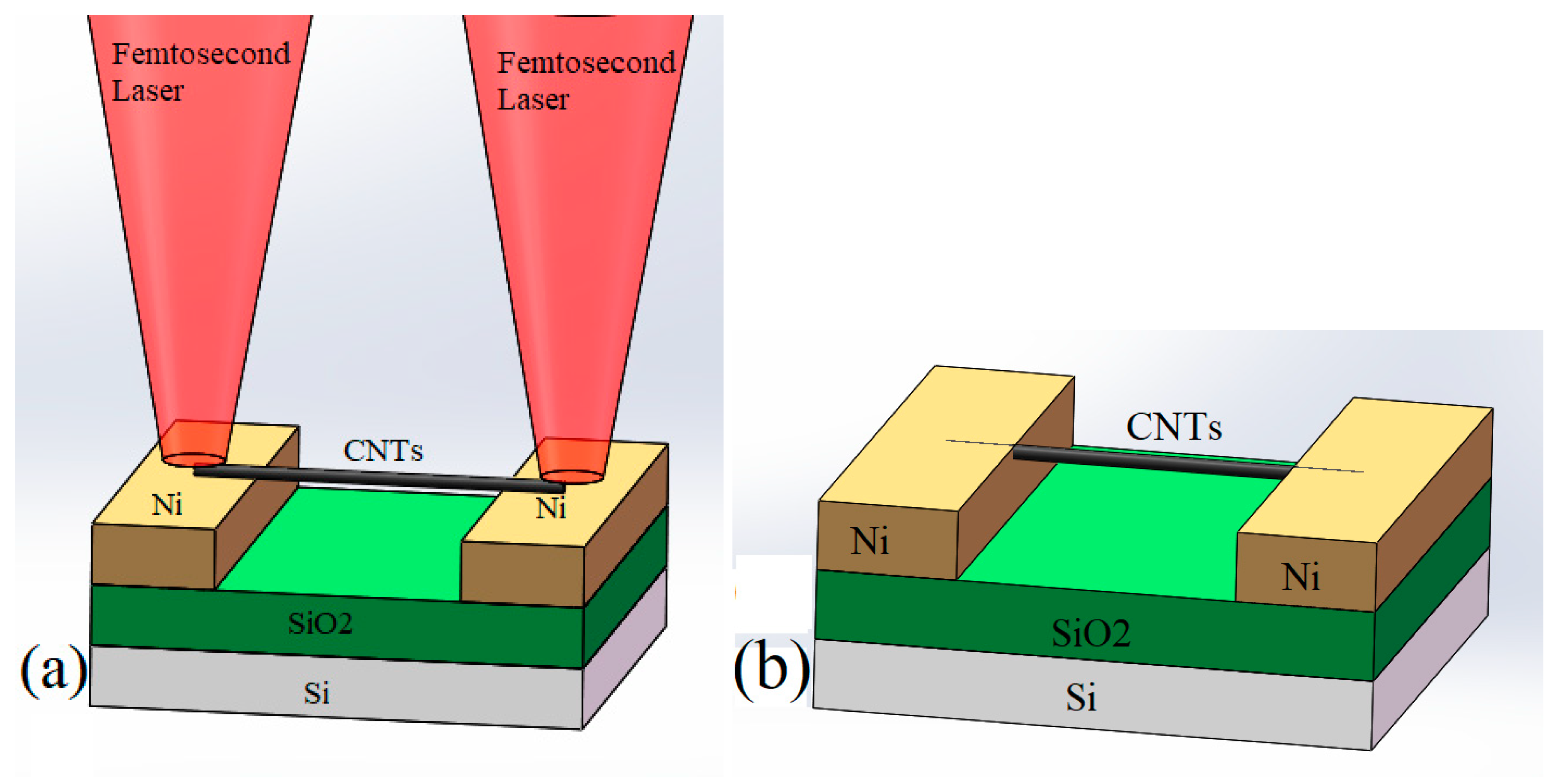
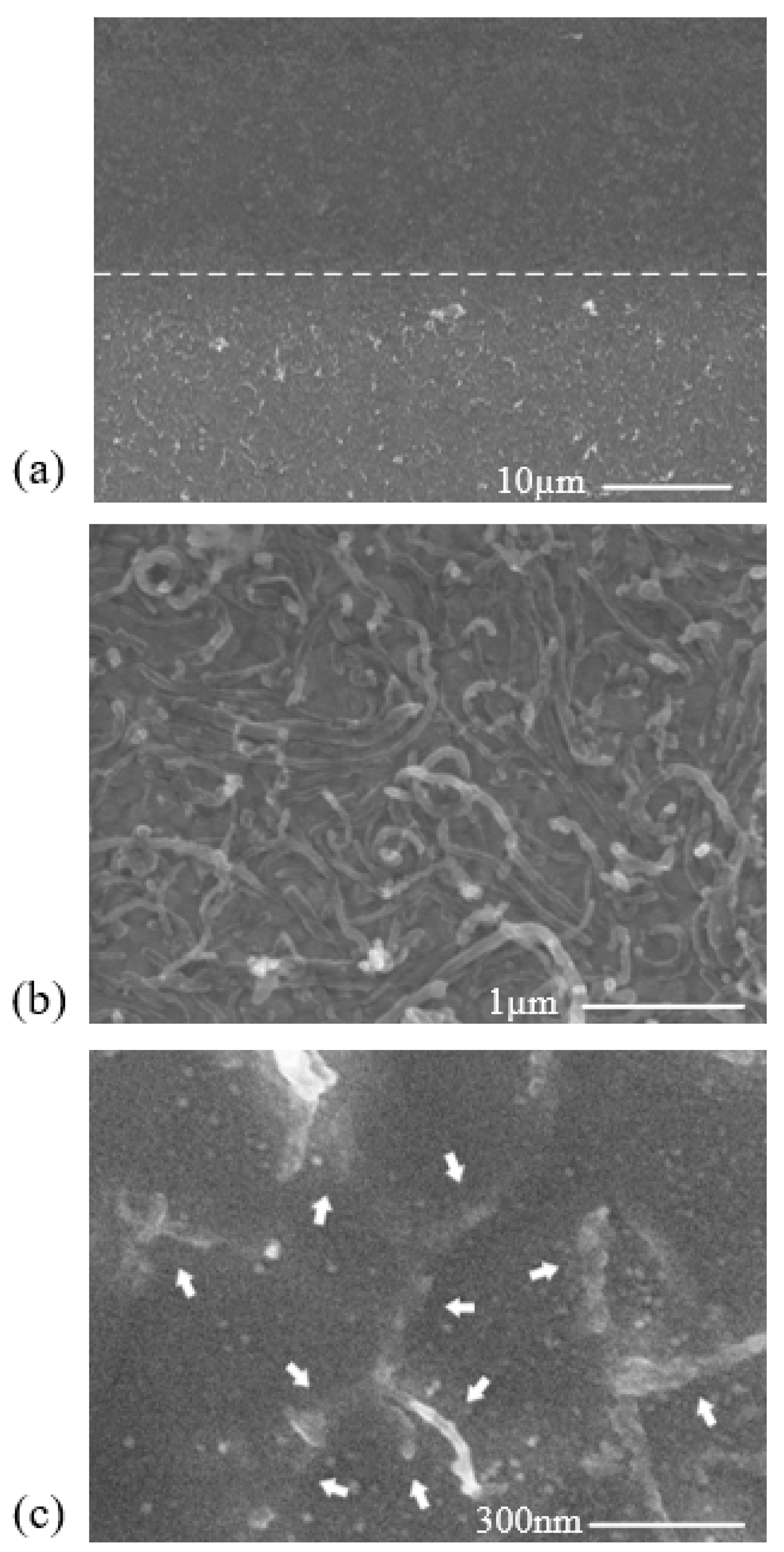
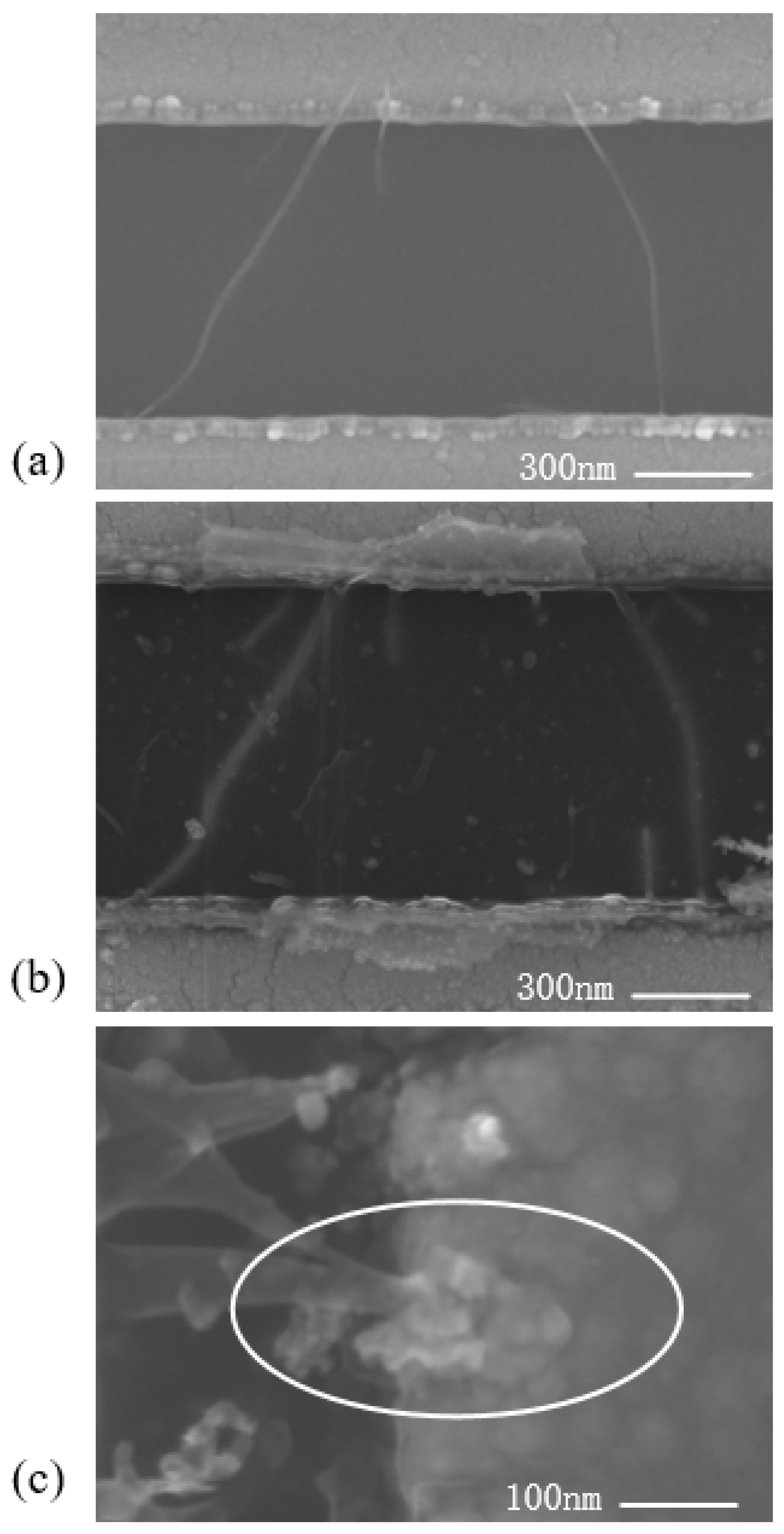
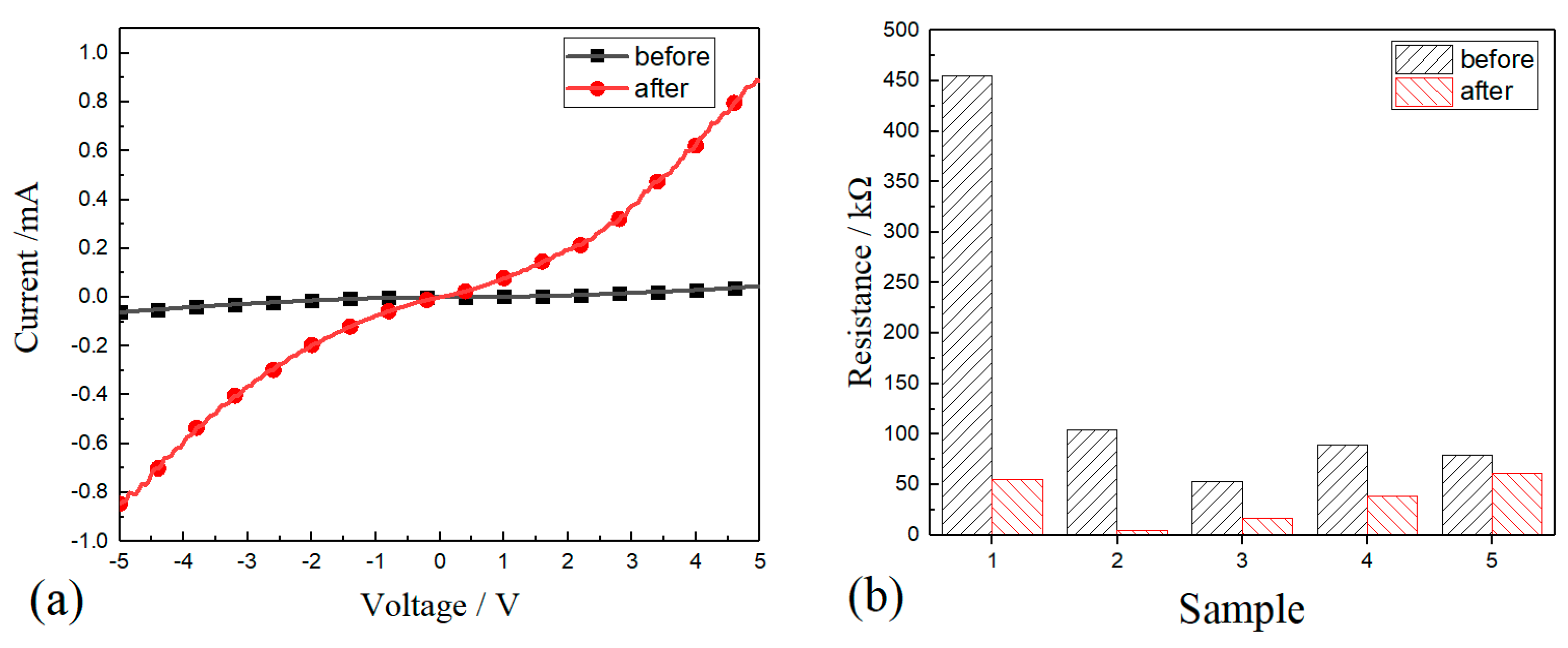
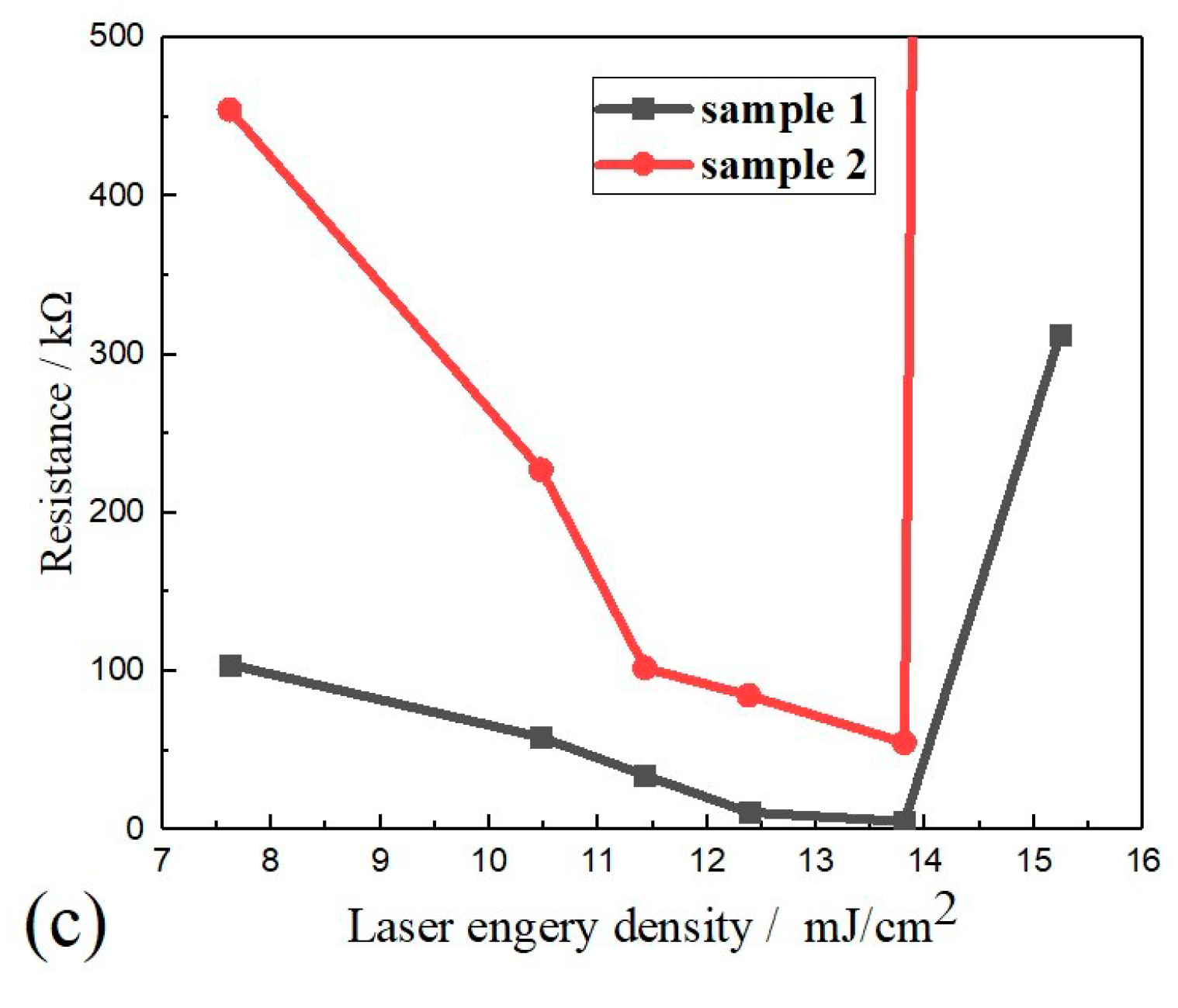
© 2019 by the authors. Licensee MDPI, Basel, Switzerland. This article is an open access article distributed under the terms and conditions of the Creative Commons Attribution (CC BY) license (http://creativecommons.org/licenses/by/4.0/).
Share and Cite
Cui, J.; Cheng, Y.; Zhang, J.; Mei, H.; Wang, X. Femtosecond Laser Irradiation of Carbon Nanotubes to Metal Electrodes. Appl. Sci. 2019, 9, 476. https://doi.org/10.3390/app9030476
Cui J, Cheng Y, Zhang J, Mei H, Wang X. Femtosecond Laser Irradiation of Carbon Nanotubes to Metal Electrodes. Applied Sciences. 2019; 9(3):476. https://doi.org/10.3390/app9030476
Chicago/Turabian StyleCui, Jianlei, Yang Cheng, Jianwei Zhang, Huanhuan Mei, and Xuewen Wang. 2019. "Femtosecond Laser Irradiation of Carbon Nanotubes to Metal Electrodes" Applied Sciences 9, no. 3: 476. https://doi.org/10.3390/app9030476
APA StyleCui, J., Cheng, Y., Zhang, J., Mei, H., & Wang, X. (2019). Femtosecond Laser Irradiation of Carbon Nanotubes to Metal Electrodes. Applied Sciences, 9(3), 476. https://doi.org/10.3390/app9030476





